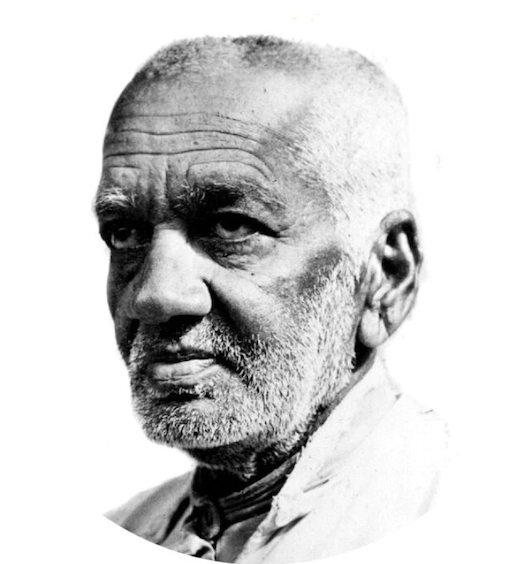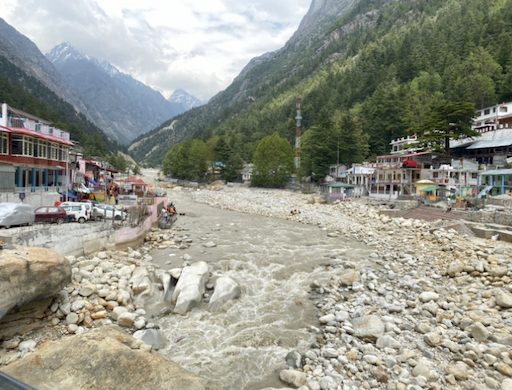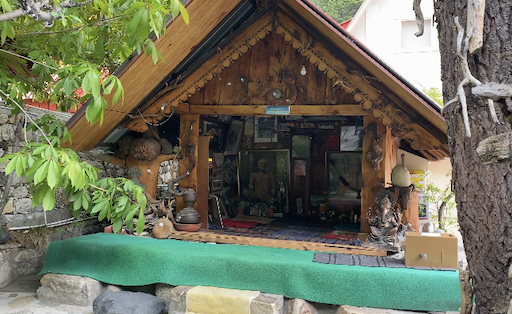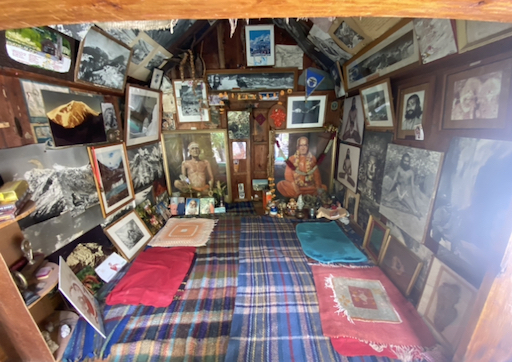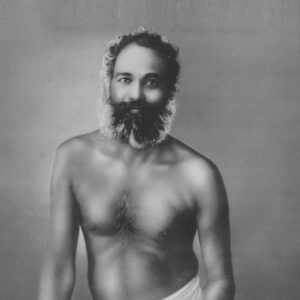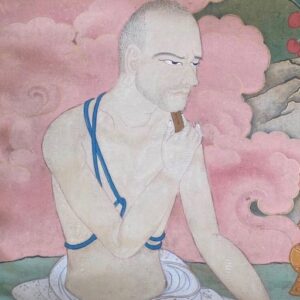This is a place where Swami Tapovanam lived until his death is 1957. This Kuti was handed down to his disciple Swami Sunderanand after his death. Today, the Kuti contains the photographs and pictures of Swami Tapovanam and Swami Sunderanand. was an Indian Yogi, photographer, author and mountaineer who lectured widely in India on threats to the Ganges River and the loss of Himalayan glaciers due to global warming. There is also Tapovan Hiranyagarbha Art Gallery next to the Kuti. This art gallery have a thousand photographs of Himalayan caves, valleys, its culture and folk life. The creation of the art gallery is credited to the famous photographer and ascetic Swami Sundaranand. This art gallery will feature the changes in Gangotri Valley in last 72 years.
There is a place to sit and meditate. You can go into meditative states here effortlessly.
How to get there:
The Kuti is 1 km across the river through bridge of Gangotri Dham.
Map: https://goo.gl/maps/KGhrA2Ef26KUtC9H6
About Swami Tapovanam
Introduction
He is history’s few, God’s own ascetic, a beacon of knowledge, and a Himalayan jewel — all rolled into one. Swami Tapovanam is a symbol of complete abidance in Truth, the light that never descended — philosophically, literally, and figuratively. He was that pristine glacier of Self-knowledge from whom flowed the Ganga of Vedantic wisdom through Swami Chinmayananda, the founder of Chinmaya Mission.
A saint of the highest order, Swami Tapovanam was a consummate Vedantin, strict teacher, a compassionate mentor, a poet whose every thought throbbed with ecstatic awareness, and a sage of unsurpassed wisdom and tranquillity. He is one of those rare sages who personifies the Absolute in every sense of the word — eternal and infinite — radiant and resplendent, dazzling with the effulgence of a million suns.
Swami Sivananda called him ‘Himavat Vibhuti,’ meaning “the glory of the Himalayas”; and in the world of sages and ascetics, he is acknowledged as one of the four great enlightened masters of Vedanta who lived in the Himalayas during the time, along with Swami Vishnudevananda, Brahmaprakasa Udasina, and Devagiri Swami.
That Truth, which Swami Tapovanam realized and indicated in all his teachings, is beyond words, as much as he himself was. Swami Chinmayananda said of his Guru, “He was a God without temple, a Veda without language.”
Monkhood
Even as a formidable scholar, Chippu Kutty’s thirst for knowledge could not be quenched by mere intellectual advances. Despite the accolades earned during his years of public speaking on literature, politics, religion, and Vedanta, he was convinced of the unsubstantial nature of worldly existence and was consumed by the fire of dispassion. Thus, he had already adopted the sannyasi’s religious and serene lifestyle long before his initiation into the ochre robe of sannyaasa.
However, since his only younger brother was still in college, he stayed on to fulfil his responsibilities as head of the family, while continuing his own personal spiritual practices and study.
Finally, at the age of twenty-eight, unable to control his spiritual hunger, Chippu Kutty left home in search of Truth. He met priests, scholars, saints and sages, devoutly read Vedic scriptures and observed austerities. He studied under a great sannyaasi and requested to be initiated into monkhood. His Guru told him, “Sannyaasa need not be given to you. You take it yourself; you are already a true sannyaasi.” Accordingly, obeying the great call from within, he went to the banks of the Narmada River, performed all the necessary acts of worship, accepted sannyaasa and called himself ‘Tyagananda.’
For seven years he travelled widely, from famous South Indian pilgrimage centres to Kolkata, to Varanasi, Haridwar and Rishikesh. It was in Rishikesh that Swami Janardhana Giri of Kailash Ashram traditionally initiated him into sannyaasa with the name, Swami Tapovanam – “forest of austerities.”
Swami Tapovanam chose to live in the then small, remote mountainous area of Uttarkashi in Uttarakhand. He lived in a one-room mud hut, with no belongings, no comforts, and no involvement whatsoever with the world. Each day, he ate one meal (a watery lentil soup and roti) and took two baths in the freezing Ganga.
This hermitage called Tapovan Kutir, in front of the sacred River Ganga, would soon acquire great fame the world over for its spiritual luminescence.
Awakening
Born in 1889 in Mudappuallur, a medium-sized village in Kerala, to Smt. Balamba and Shri Achhutan Nair, Chippu Kutty, as Swami Tapovanam was known, exhibited a marked partiality for spiritual life. As a child, he was fascinated and delighted by Pauranic stories manifesting the glories of God and the worship of idols fashioned by his own hands.
His early education started with the village teacher. Too intelligent to be trained within the formal learning systems of his time, he sought a different education – less materialistic and more spiritual. Home-schooled until the age of 17, he proved himself to be a devout Vedantin, and a linguistic genius and litterateur par excellence, mastering poems, dramas, grammar and logic in both Malayalam and Sanskrit. Chippu Kutty’s first poem ‘Vibhakarom’ composed at the age of eighteen attracted the attention of literary scholars and received wide applause.
Both his parents passed away before he turned 21. By then, he was already renowned and revered for his original poetic compositions. An introvert to the core, he loved spending his time immersed in books, japa, meditating on the form of Lord Shiva and spiritual reflection. He was averse to all worldly pleasures. Charmed by the beauty of nature, he spent much of his time in the jungles near his father’s house. “The starry sky lit with the bright full moon filled his mind with celestial thoughts of ineffable bliss,” he wrote in Iswara Darshan
The Teacher
Filled with divine Light, the compassionate sage shared words of wisdom with all devotees who came to him in search of spiritual knowledge, but rarely did he accept resident disciples. Monks, householders, pilgrims, and seekers from all stages and fields of life continually thronged to Uttarkashi to be in the presence of, and learn from, this Self-realized master and erudite scholar.
When Swami Tapovanam did accept a resident disciple, the latter was trained under the strictest conditions. In all, thirty-five or so students came with enthusiasm, at one point or another, to study under him. There were very few who could undergo and survive such hardships, but those seekers who did, were blessed by the Master with supreme Enlightenment.
When Swami Chinmayananda requested the sage to teach him, He told the curious ‘Chinmaya,’ that he would say everything he had to teach once only, and Chinmaya would have to repeat it the very next day; if he forgot anything, he would have to leave. Swami Tapovanam believed that the highest Knowledge was not for everyone, but only for those who yearned and searched for it.
He was, of course, an incredible teacher of Vedanta. It might have been impossible to live under the same exacting conditions, but it was equally impossible to resist his brilliance, outside and within. His teachings came from the innermost depths of his illumined being, and, as such, they were the quintessence of pure, unalloyed Self-awareness.
In the hot summer season, Swami Tapovanam would retreat ninety kilometres further up the Himalayas to Gangotri. As one of his disciples, Swami Chinmayananda accompanied him. Living conditions in Gangotri were tough. Removed from the comforts of civilization, there was no nutritious food, warm clothing, adequate shelter, or electricity for reading; and no talking was allowed among disciples, not with a disciplinarian for a Guru.
Each day began with an icy cold bath in the Ganga, waking up for morning class at 6 a.m. Following the Vedic tradition, class would begin with a prayer and continued for a few hours daily. The rest of the time was spent in reflection, prayer, meditation, and service of the Guru. During scriptural study, Swami Tapovanam would read out one verse of the text, and then give the equivalent meaning in Hindi. Word by word, he explained the Sanskrit, giving the rules of grammar, as well as possible interpretations and misinterpretations of the meaning.
Aside from scriptural study, there were lessons learned daily from the austere life and living example of the Guru. Once, a basket of laddoos arrived just as the class had begun. Swami Tapovanam directed them to be kept inside. The students waited, eagerly, for their guru to distribute the delicious sweets. But, even after a few days, no laddoos appeared. Some disenchanted students, suspecting that the Master was keeping all them for himself, actually left. On the fifth day, Swami Tapovanam ordered the basket to be brought before the class. It was exactly as it had arrived with all the laddoos intact. “To the Ganga! Throw them out!” he thundered. “Just look at the quality of your minds, agitated over a paltry basket of sweets…We’re here to study the Upanishads, not to eat laddoos!”
Thus, Swami Tapovanam never missed an opportunity to teach the ideals of spiritual life and discipline in practical situations. His goal was to turn the student’s mind beyond material concerns even in their daily routines.
This pure-hearted monk saw God in everything. He would often stop in his wanderings to point out the majestic scenery saying, “Why can’t man see Divinity behind the ecstatic Artist who has painted this inspired beauty?”
His devotion to the holy river Ganga — which he considered as the Ultimate Truth in liquid form — drew him to always live within hearing distance of its sweet rumblings, either at Uttarkashi or Gangotri. A local sannyaasi remarked, “Gangotri and Uttarkashi lost their glory when Swami Tapovanam left his mortal coil.”
Swami Tapovanm’s deep love for the sights and sounds of nature had brought him to the Himalayas, where he became renowned as a scholar of the scriptures, a sage of extraordinary spiritual experiences, and an intuitive poet. “As he roamed the Himalayan peaks, his pen was constantly scribbling down the beauties he discovered and the thoughts passing through his sacred bosom,” wrote Swami Chinmayananda.
As a jivanmukta or Self-realized master, he saw the supreme Lord in all expressions, within and without. He developed a new style of literature with his poetry on nature and philosophical travelogues. In his inspiring works – both in Malayalam – of Himagiri Viharam (Wanderings in the Himalayas) and Kailasa Yatra (Pilgrimage to Kailasa) are seen the full flow of his blissful and soulful renderings of nature, and the profundity of his subtle observations and reflections. He also wrote smaller pieces in Sanskrit, such as ‘Sri Saumya Kashish Strotram’ – each an exquisite piece of poetry as well as a summary of Vedantic truths.
However, it is his mystical autobiography, a garland of spiritual thoughts, Iswara Darshan (Vision of the Lord), that sages and seekers the world over have stamped as his masterpiece.
“His Life and personality are indeed most precious and invaluable, for they form a lofty example of what true Vedanta and true sannyaasa have to be…Such exceptional Sannyaasins as Tapovanji are a glory to this land with its ancient ideals of renunciation and Cosmic Service. They are a treasure to the entire humanity.”-Swami Sivananda, founder-President,Divine Life Society
Read More
https://www.chinmayamission.com/who-we-are/swami-tapovan-maharaj/
